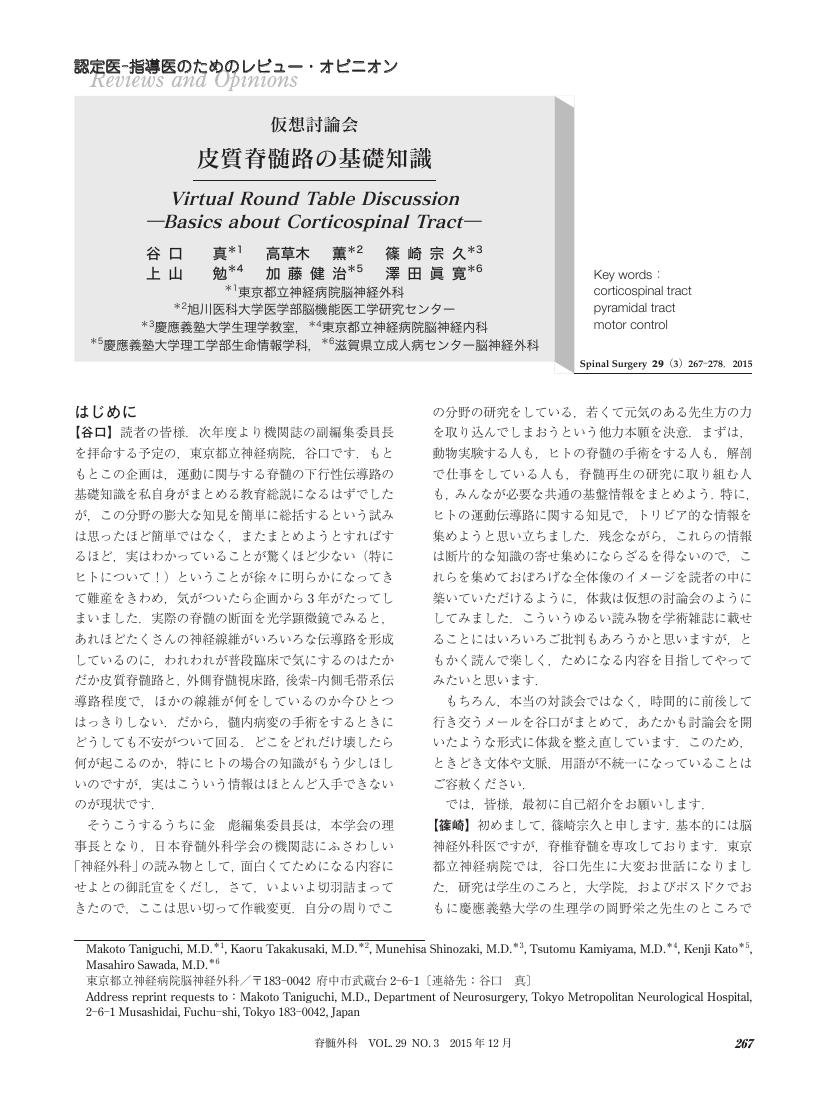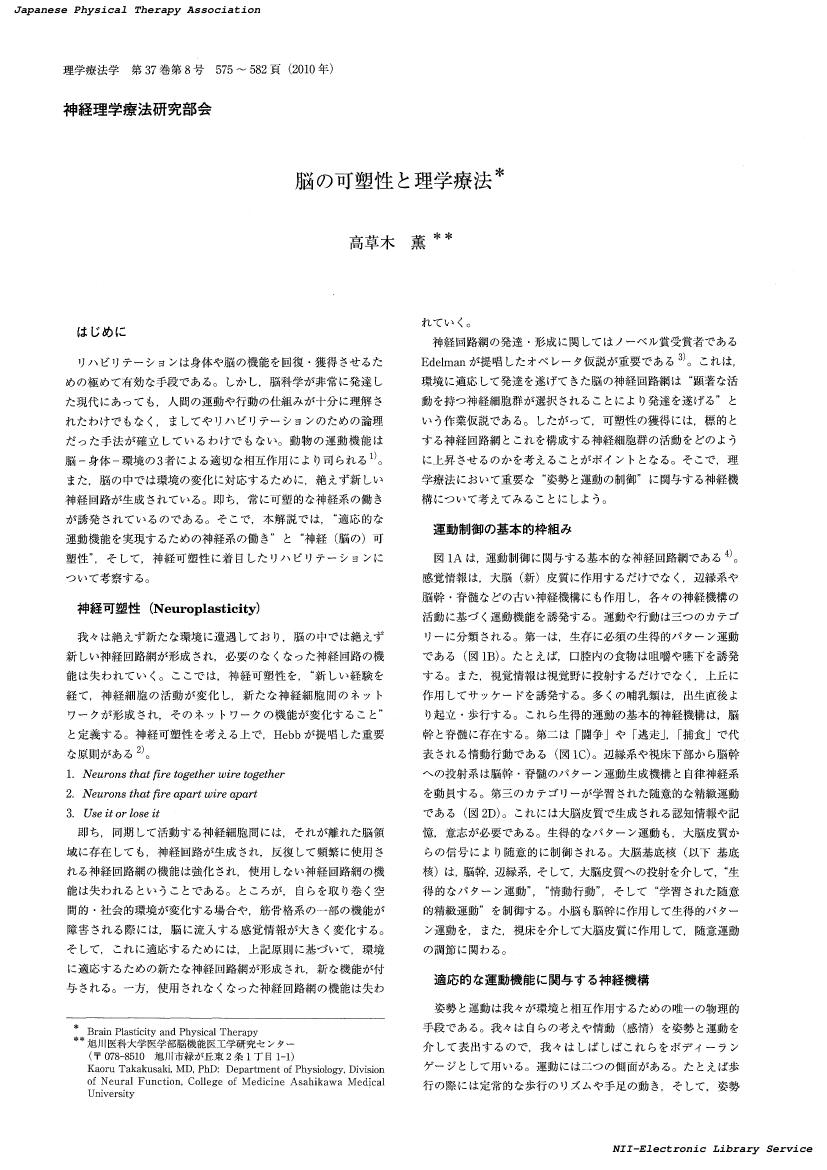81 0 0 0 OA 大脳皮質・脳幹-脊髄による姿勢と歩行の制御機構
- 著者
- 高草木 薫
- 出版者
- 日本脊髄外科学会
- 雑誌
- 脊髄外科 (ISSN:09146024)
- 巻号頁・発行日
- vol.27, no.3, pp.208-215, 2013 (Released:2017-05-11)
- 参考文献数
- 39
- 被引用文献数
- 1
This review discusses neuronal mechanisms controlling posture and locomotion. Volitional gait behaviors are composed of “automatic control of posture and rhythmic limb movements” that operate in conjunction with “intentional control of precise movements of the trunk, limbs, and feet.” The automatic control of posture and rhythmic limb movements is mediated by the ventromedial descending motor system from structures of the brainstem. Descending signals in this system activate spinal interneuronal circuits, which are termed central pattern generators (CPGs), to automatically generate a locomotor rhythm and pattern in cooperation with sensory afferents from muscles, joints, and skin. However, when moving, the subject requires intentional gait modification, which in turn critically involves an activation of the dorsolateral descending motor system, or the lateral corticospinal tract, arising from the motor cortical areas. An intentional gait control is always preceded by appropriate postural adjustments, which are themselves achieved by the motor programs in motor cortical areas including the supplementary motor area and premotor area. To generate and develop the motor programs, information of bodily function such as body schema, which is always updated at the temporoparietal cortex on the basis of proprioceptive, visual, vestibular and auditory sensations, can be critically required. The postural control program is propagated to the brainstem, via the cortico-reticular projection, so that anticipatory postural adjustment is performed by the activation of the ventromedial systems immediately before the onset of the intentional gait modification. Conversely, programs of intentional gait control are transmitted to the primary motor cortex so that precise limb trajectories can be generated and accurate foot placement is achieved by the activation of the corticospinal tract. Signals from the basal ganglia and the cerebellum regulate “automatic processes” by acting on the brainstem and “intentional processes” by acting on the cerebral cortex. Operation of the basal ganglia is largely affected by dopamine, and cerebellar function depends on feed-forward and feedback signals acting on the cerebellum. Dysfunction of either mechanism of the above processes may result in postural disturbance and/or gait failure. (328 words)
17 0 0 0 OA 姿勢の進化・発達と退化
- 著者
- 高草木 薫 高橋 未来 野口 智弘 千葉 龍介
- 出版者
- 公益社団法人 計測自動制御学会
- 雑誌
- 計測と制御 (ISSN:04534662)
- 巻号頁・発行日
- vol.61, no.4, pp.294-302, 2022-04-10 (Released:2022-04-15)
- 参考文献数
- 63
8 0 0 0 OA 大脳基底核による運動の制御
- 著者
- 高草木 薫
- 出版者
- 日本神経学会
- 雑誌
- 臨床神経学 (ISSN:0009918X)
- 巻号頁・発行日
- vol.49, no.6, pp.325-334, 2009 (Released:2009-07-08)
- 参考文献数
- 26
- 被引用文献数
- 17 10
大脳皮質は認知的な随意運動の発現に,脳幹―脊髄は姿勢反射や筋緊張,歩行などの生得的な運動に,そして,大脳皮質から脳幹への皮質網様体投射は随意運動に先行する姿勢制御に関与する.大脳基底核は強力な抑制作用と脱抑制によって,大脳皮質と脳幹の時間的・空間的な活動動態を協調的に制御し,適切な運動機能の発現に寄与する.したがって,大脳基底核の障害やこれを修飾するドーパミン作動系の異常により,この協調的な調節機構が破綻すると,随意運動や姿勢筋緊張,そして,歩行の異常など,基底核疾患に特有の運動障害が出現する.
7 0 0 0 OA 移動知: 行動からの知能理解-構成論的観点と生物学的観点から
- 著者
- 高草木 薫 淺間 一
- 出版者
- 公益社団法人 計測自動制御学会
- 雑誌
- 計測と制御 (ISSN:04534662)
- 巻号頁・発行日
- vol.44, no.9, pp.580-589, 2005-09-10 (Released:2009-11-26)
- 参考文献数
- 13
- 被引用文献数
- 3
6 0 0 0 OA 仮想討論会 皮質脊髄路の基礎知識
5 0 0 0 OA 脳内オレキシンシグナル低下はIBSの病態を引き起こす
過敏性腸症候群(IBS)の主要病態である内臓知覚過敏の中枢メカニズムを解明することを目的にした。内臓知覚はラットの直腸にバルーンを装着し伸展させることで内臓痛を生じさせる実験系で検出した。オレキシンの脳室内投与は内臓知覚鈍麻を誘導すること。モルヒネ、levodopaやグレリンによる内臓知覚鈍麻はこのオレキシンによる内臓知覚鈍麻作用を利用していること。オレキシンによる内臓知覚鈍麻作用は脳内ドパミン、アデノシン、カンナビノイド シグナルを介していることが明らかにできた。これらの結果からオレキシン シグナルの低下はドパミンなどを介して内臓知覚過敏を誘導し過敏性腸症候群の病態形成に深く関与すると考えた
3 0 0 0 OA 大脳基底核による運動制御機構
- 著者
- 高草木 薫
- 出版者
- The Robotics Society of Japan
- 雑誌
- 日本ロボット学会誌 (ISSN:02891824)
- 巻号頁・発行日
- vol.23, no.1, pp.2-5, 2005-01-15 (Released:2010-08-25)
- 参考文献数
- 15
- 被引用文献数
- 5 2
2 0 0 0 OA 脳の可塑性と理学療法
- 著者
- 高草木 薫
- 出版者
- 一般社団法人日本理学療法学会連合
- 雑誌
- 理学療法学 (ISSN:02893770)
- 巻号頁・発行日
- vol.37, no.8, pp.575-582, 2010-12-20 (Released:2018-08-25)
- 参考文献数
- 20
- 被引用文献数
- 2
1 0 0 0 OA 身体・脳・環境の相互作用による適応的運動機能の発現に関する総括研究
1 0 0 0 IR 【歩行】 歩行の神経機構Review
- 著者
- 高草木 薫
- 雑誌
- Brain Medical (ISSN:09155759)
- 巻号頁・発行日
- vol.19, no.4, pp.307-315, 2007-12
- 被引用文献数
- 4
著者版歩行には3つのプロセスがある。第1は、正確な制御を必要とする随意的プロセスであり、これは大脳皮質からの随意的な信号により遂行される。第2は、捕食や逃避、逃走など情動的プロセスであり、辺縁系や視床下部から脳幹への投射系が関与する。第3は、歩行時のリズミカルな肢運動や姿勢調節など、無意識に遂行される自動的プロセスであり、脳幹と脊髄におけるsensori-motor integrationが重要な役割を果たす。大脳基底核や小脳は、大脳皮質、辺縁系・視床下部、そして脳幹に作用して歩行を制御する。




